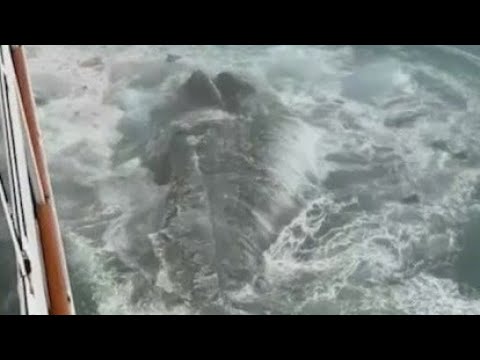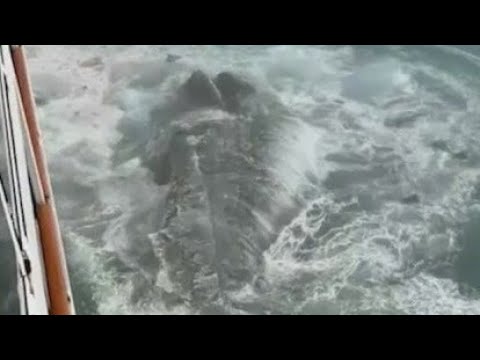You won’t believe what happened to a Norwegian Cruise Line ship recently. While on its way to the Hubbard Glacier in Alaska, the ship collided with an iceberg, causing significant damage to the front. Passengers on board compared the experience to “Titanic 2.0,” although luckily, no one was hurt. The ship had to cancel the remainder of the cruise, but authorities quickly inspected and cleared it for repairs. It’s a fascinating and somewhat unbelievable incident that highlights the power and unpredictability of nature.

Norwegian Cruise Line ship damaged after hitting iceberg in Alaska
On an ill-fated journey to the Hubbard Glacier in Alaska, a Norwegian Cruise Line ship recently experienced a dangerous collision with an iceberg, leading to the cancellation of the remainder of the cruise. The ship in question, the Norwegian Sun, was struck by what is known as a “growler” – a piece of ice that has broken off from a larger glacier or shelf ice.
Description of the incident
According to the National Oceanic and Atmospheric Administration (NOAA), a growler is roughly the size of a truck and is typically less than 3 feet in height above the sea surface. These ice formations can occupy an area of more than 200 square feet. The impact of the collision caused the Norwegian Sun to come to a sudden and complete stop, shocking passengers on board.
What is a growler?
A growler is a unique term used to describe a smaller piece of ice that has separated from a larger glacier or shelf ice. These ice formations are typically smaller in size compared to icebergs, measuring less than 3 feet in height above the water’s surface. Despite their smaller size, they can still pose a significant risk to ships navigating through icy waters.
Eyewitness Account
Impact of the collision
Passengers on board the Norwegian Sun were left in awe as the ship was hit by the growler. Benjamin Talbott, a witness to the incident, expressed his surprise as the ship abruptly came to a halt. He described the moment, saying, “Then all of a sudden, boom, the whole ship shakes. And I’m like, ‘Well, what’s going on?'”
Passenger reactions
The collision with the iceberg left many passengers in a state of shock and disbelief. Some compared the experience to the infamous sinking of the Titanic, dubbing it “Titanic 2.0.” However, it’s important to note that no injuries were reported, and the ship itself was inspected and deemed safe for travel at lower speeds by authorities.
Video footage of the incident
The incident was captured on video by a family from Nevada who happened to be on board the Norwegian Sun. Their footage shows the moment of impact and the reactions of passengers. The video serves as a chilling reminder of the force and unpredictability of nature’s icy obstacles.
Assessment of Damage
Evaluation of the ship’s condition
After the collision, the Norwegian Sun underwent a thorough evaluation to assess the extent of the damage. Fortunately, while the ship sustained damage to its front, it was deemed to be in overall stable condition. This provided some relief to both the passengers and the cruise line.
Inspection by authorities
Following the incident, authorities conducted a detailed inspection of the ship to ensure its continued safety. The inspection determined that the Norwegian Sun could proceed with caution at lower speeds as it made its way to Seattle for necessary repairs.
Clearance for travel with lower speeds
While the ship received clearance to continue its journey at reduced speeds, it was clear that further repairs were needed. The priority was to transport the passengers safely to their destination while minimizing any potential risks.
Passenger Safety
No reported injuries
Thankfully, there were no reported injuries among the passengers and crew members on board the Norwegian Sun. Despite the frightening nature of the collision, everyone managed to escape unharmed. This provided a sense of relief to those involved and to their families back home.
Comparison to the Titanic incident
While some passengers likened the collision to the Titanic disaster, it’s important to recognize the significant differences between the two events. The Norwegian Sun was able to withstand the impact and did not suffer any fatal consequences. Lessons learned from past maritime disasters, including the Titanic, have undoubtedly played a role in preventing greater tragedy in situations like these.
Media Coverage
FOX 5 New York coverage
FOX 5 New York was among the media outlets that covered the Norwegian Cruise Line ship’s collision with an iceberg. The incident garnered significant attention due to the striking nature of the event and the comparison drawn to the Titanic. News reports provided updates on the situation, ensuring that viewers remained informed.
Video footage from passengers
In addition to news coverage, video footage captured by passengers on board the Norwegian Sun circulated on various media platforms. These videos offered viewers a firsthand perspective of the intense moment of impact and the subsequent reactions of those on board.
Witness testimonies
Eyewitness testimonies from passengers, such as Benjamin Talbott, added a personal touch to the media coverage. Their accounts provided a deeper understanding of the emotions and experiences of those who were directly impacted by the collision. These testimonies helped create a comprehensive narrative surrounding the incident.
Investigation
Determining the cause of the collision
Following the incident, an investigation was initiated to determine the cause of the collision. Experts with knowledge of maritime safety and navigation methods were brought in to analyze the circumstances leading up to the accident. The investigation aimed to shed light on any potential factors that may have contributed to the ship’s encounter with the growler.
Review of safety measures on the ship
As part of the investigation process, a thorough review of the safety measures implemented on the Norwegian Sun was conducted. This review aimed to identify any potential gaps in safety protocols that may have impacted the ship’s ability to navigate safely through icy waters.
Use of radar and other navigational equipment
One notable area of focus during the investigation was the ship’s radar and other navigational equipment. It was crucial to determine whether these systems were functioning properly and whether they provided sufficient warning of the iceberg. The investigation sought to answer questions regarding the actions taken to avoid the collision and whether any system failures or human error occurred.
Repairs and Cancellations
Cancellation of the remainder of the cruise
In light of the collision, Norwegian Cruise Line made the difficult decision to cancel the remainder of the affected cruise. This decision was made with the safety and well-being of passengers as the top priority. The cancellation allowed the cruise line to focus on necessary repairs and create alternative arrangements for affected passengers.
Transportation arrangements for passengers
Efficient and organized transportation arrangements were made to ensure that passengers could safely return to their respective destinations. Norwegian Cruise Line worked diligently to accommodate passengers and alleviate any inconveniences caused by the cancellation of the cruise.
Timeline for repairs
Following the cancellation, the Norwegian Sun underwent repairs to address the damages sustained during the collision. A precise timeline for repairs was not provided, as the extent of the damage needed to be determined before an estimated completion date could be established. The cruise line assured passengers and the public that repairs would be carried out promptly and with great attention to detail.
Lessons Learned
Importance of safety measures
The incident involving the Norwegian Cruise Line ship hitting an iceberg serves as a reminder of the critical importance of safety measures in maritime operations. The safety and well-being of passengers and crew members must always remain the top priority, and comprehensive safety protocols should be in place to navigate through potentially hazardous waters.
Preventive measures for future incidents
Given the unpredictable nature of icy waters, it is essential for cruise lines and other maritime entities to continuously assess and improve upon safety measures. Lessons learned from incidents like this one should be utilized to enhance navigation systems, ensure regular safety drills and training for crew members, and provide passengers with the information and resources needed to stay safe in any situation.
Conclusion
The collision between the Norwegian Sun and an iceberg in Alaska served as a stark reminder of the potential dangers faced by ships navigating through icy waters. While the incident evoked memories of the Titanic, it is crucial to recognize the differences in outcomes and the progress made in maritime safety over the years.
The safety of passengers and crew members remains paramount, and incidents like this highlight the ongoing need for robust safety measures and thorough investigations into any accidents that do occur. By continuously learning from past incidents and implementing preventive measures, the cruise industry can work towards ensuring the safety and enjoyment of everyone on board their vessels.

